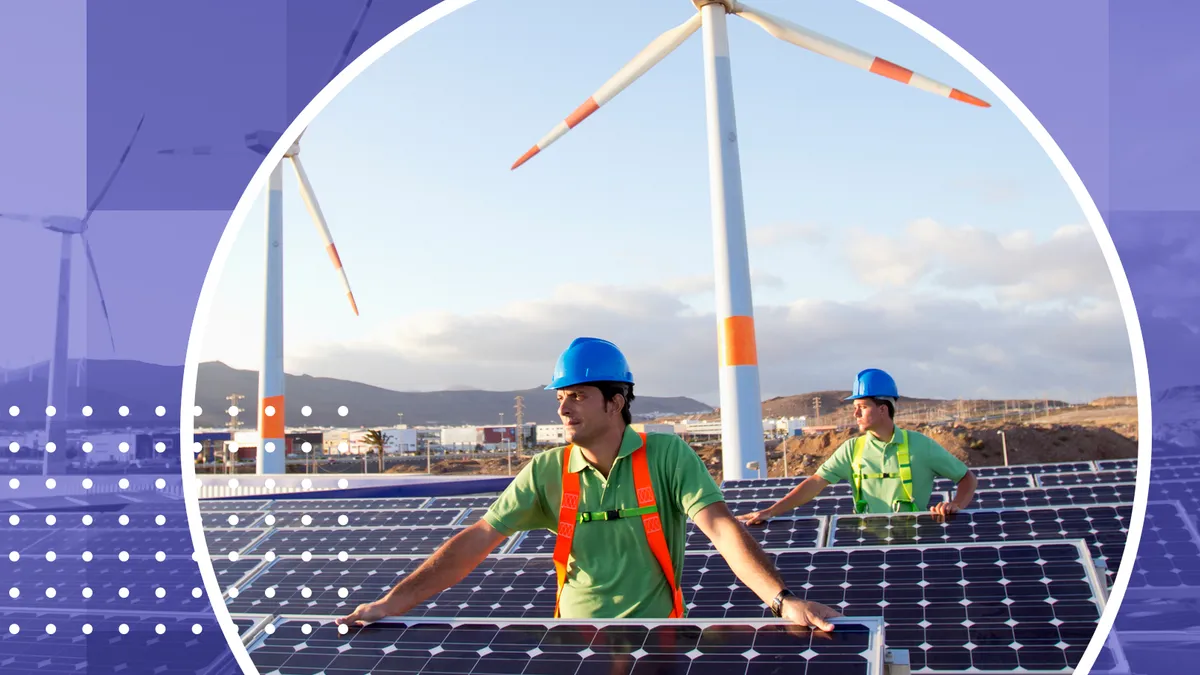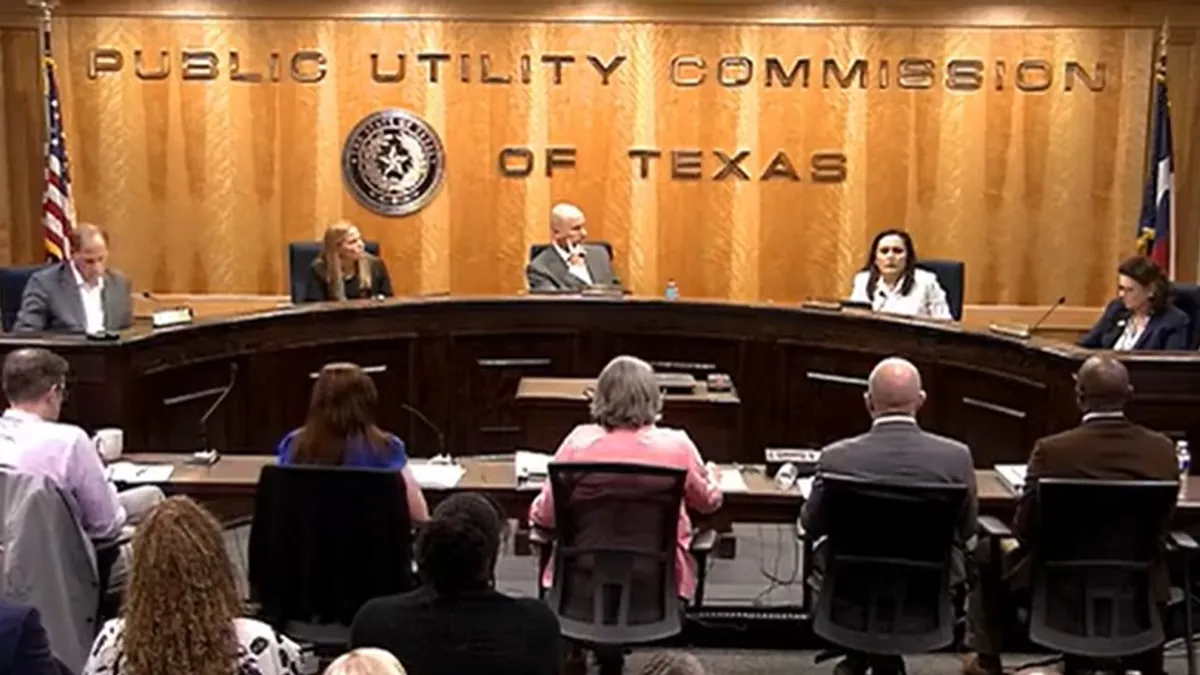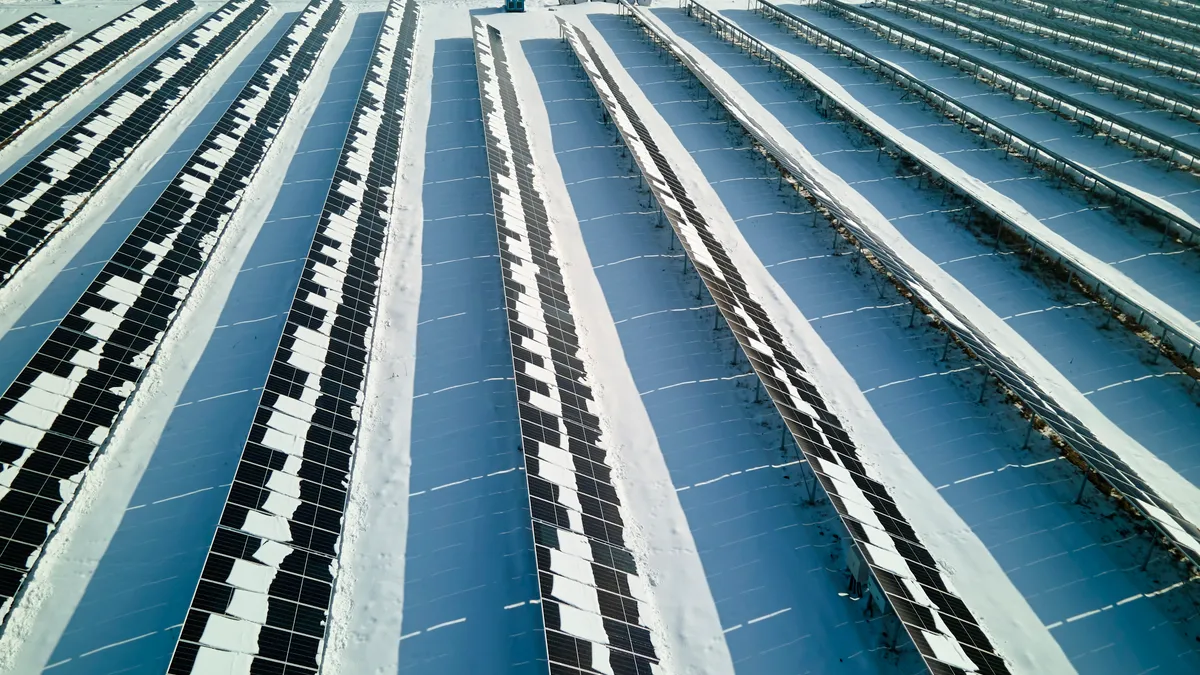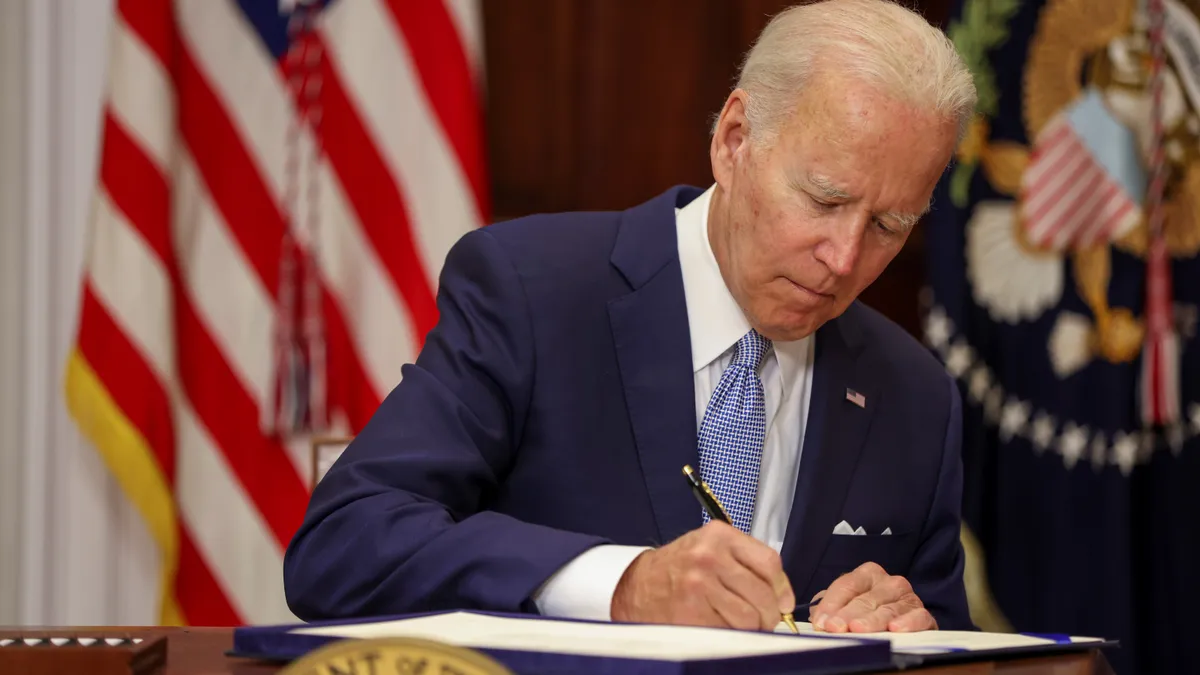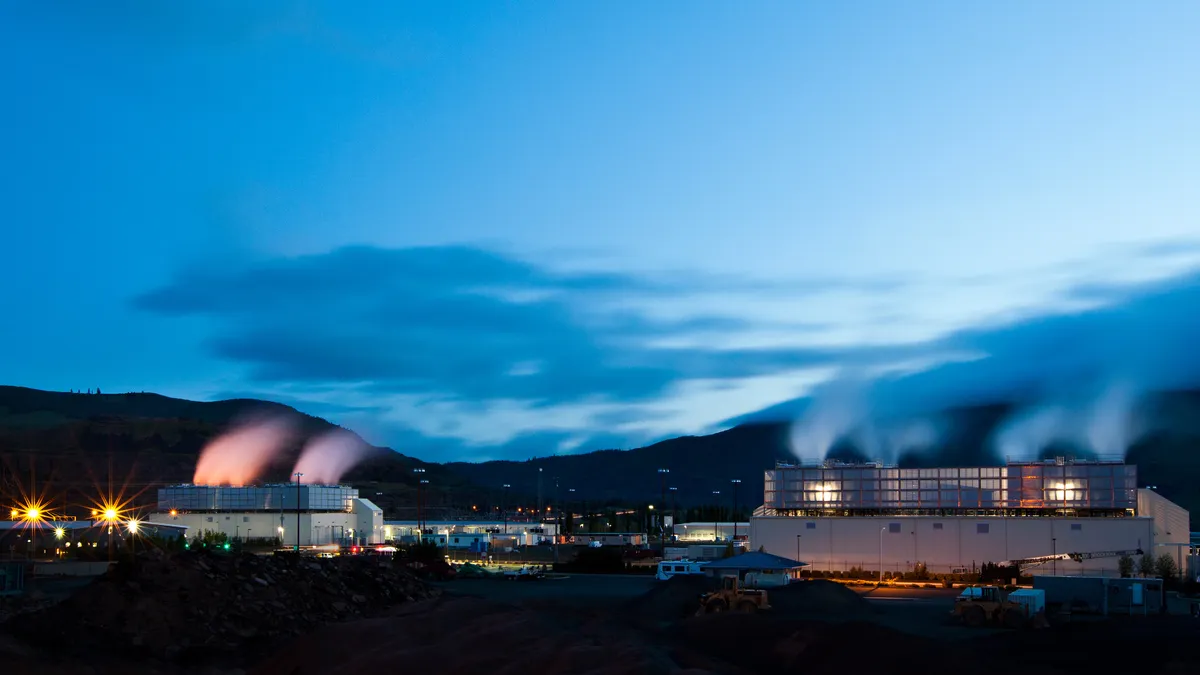The U.S. power sector is undergoing a fundamental transformation, and has been for some time. But what are the biggest trends to watch in 2020? In speaking to a cross section of industry observers, the following 10 emerged.
Renewables, storage, DER grow increasingly competitive with traditional supply options
The economics of wind, solar and storage will continue to improve in 2020, creating a variety of implications seen in many of the other trends below.
"We're seeing time and again, whether it's in planning processes that are conducted by utilities, whether it's in open solicitations in markets ... that using combinations of wind, solar and storage is more cost effective for customers than really any other options, including relying on existing aging coal assets or even building new natural gas assets," Jeff Dennis, managing director and general counsel at Advanced Energy Economy (AEE), told Utility Dive.
"The big trend is that there is going to be a continuing decline in the price and a continuing improvement in the ability to both forecast and manage [renewables], which is going to further accelerate those price declines," Tim O'Connor, a senior director in Environmental Defense Fund's Energy Transitions Strategy, told Utility Dive.
The trend of improving economics for clean energy technologies has accelerated over the past year to 18 months, but Dennis expects it to continue at the current pace, pointing to the latest levelized cost of energy data from Lazard, released in November, which showed the cost of storage and renewables continuing to fall, though not as fast as before.
The primary obstacle that could impact the trend is the political headwinds that can arise when an industry goes through a massive transition and there are economic winners and losers, he noted.
But while all these clean energy resources are expected to see significant growth in 2020, Amanda Levin, a policy analyst with the Natural Resources Defense Council, said wind in particular will see a huge buildout throughout 2020 due to the pending expiration of the production tax credit at the end of the year.
The continuing cost declines in renewable resources makes them increasingly attractive to end users, leading to growth across local, state and corporate sectors.
Cities, states and companies increase renewable commitments
Rise in corporate commitments
2019 was a record breaking year for U.S. corporate renewable energy purchases, according to the Renewable Energy Buyers Alliance, with 7.15 GW of deals announced by the end of October.
While major tech companies like Google, Facebook and Microsoft have been leading this trend, a variety of non-tech companies are starting to enter the space, including Walmart, Target, Mars, Macy's and Honda, Levin noted.
"If people are building new gas now, they understand what the long term horizon is with respect to trying to get to net zero [emissions]. They've probably made some sort of commitment on their own about emissions reductions and so they don't do that without having crunched all the numbers."

Emily Fisher
General Counsel, Edison Electric Institute
Doing such deals through utility-offered green tariffs has become less common in recent years, while virtual power purchase agreements, whereby corporate buyers sign with a renewable developer and bypass the utility, are growing, she said.
The big question is going to be how utilities can offer products that cities and corporations with these goals want, without passing costs on to other customers. "How can they offer — under their regulated structure — products that work for everyone?" she said.
States pursue 100% clean energy goals
In 2019, five states and Puerto Rico, adopted laws targeting 100% clean energy, while three governors issued executive orders with similar goals.
Two significant factors driving the trend were the federal government's continued changes to climate and other environmental policies, and the election of eleven new Democratic governors in November 2018, with many of them making clean energy a priority.
The Midwest could emerge as a leader on clean energy in 2020, Mackinnon Lawrence, research director at Navigant Research, told Utility Dive
"There seems to be quite a bit of will to pursue some of these alternatives, but there's going to be more of an interplay with traditional sources of power there." he said.
The increasingly favorable economics for renewables — and the rise in demand for such resources — also coincides with the increasingly poor economics of coal.
Coal's long-term decline continues
2019 had a significant amount of coal retirements, with the Energy Information Administration forecasting in its December 2019 Short Term Energy Outlook that coal's share of U.S. electric generation would drop from 28% in 2018 to 25% in 2019. And the trend is expected to continue, with coal projected to fall to 22% of U.S. generation in 2020.
But while these shutdowns have been occurring for a number of years, two new elements have emerged to help with the transition.
In Montana, Colorado and New Mexico, a financial strategy known as securitization, whereby utilities can issue bonds to help pay off stranded coal assets, is now allowed.
Another change that has emerged is a greater focus on ensuring plant closures don't leave surrounding communities in a lurch, NRDC's Levin noted.
But while Levin highlighted emerging developments related to coal plant shutdowns, supporting coal-fired generation remains a goal of the Trump Administration.
"I think we're going to see a continued acceleration of the retirement of coal plants, and probably ... as those older plants get farther and farther in the red, an increase in the uneconomic efforts to bail them out," especially in 2020 battleground states, O'Connor said.
American Public Power Association Senior Vice President for Advocacy and Communications and General Counsel Delia Patterson echoed O'Connor's views on accelerating coal plant closures.
While power plant shutdowns have mostly impacted coal and nuclear-powered generation, the proliferation of energy storage, renewables and distributed resources may also interrupt the market for the country's current top power resource — natural gas.
Increasing questions about the future of natural gas
While gas is expected to be the dominant generating resource in the U.S. through 2050, the need for additional capacity is increasingly coming into question. A Rocky Mountain Institute study released in September found that if all currently proposed gas plants are built, 70% will become uneconomic by 2035.
But Edison Electric Institute General Counsel Emily Fisher disputed the notion that such investments would be imprudent.
"If people are building new gas now, they understand what the long term horizon is with respect to trying to get to net zero [emissions]. They've probably made some sort of commitment on their own about emissions reductions and so they don't do that without having crunched all the numbers," she told Utility Dive.
"It’s increasingly becoming the trend — how to deal with the tension between state policy objectives and markets that have been, to date, fuel agnostic and fuel neutral."

Sebastian Lombardi
Partner, Day Pitney
Nevertheless, NRDC's Levin sees questions surrounding natural gas coming increasingly into play in the Southeast, especially with utilities like Dominion and Duke.
She criticized the idea, raised by some utilities, that they need to add gas capacity to support higher levels of renewables.
Fisher countered that by pointing to the interconnected nature of the electric system and noting that sometimes it really matters where a particular resource is located with respect to its ability to provide the services needed to keep the system reliable.
"I highly dispute the fact that all existing gas plants can provide all of the reliability services we might need as we continue to build out renewables because they might not be in the right spots," she said.
But while gas may become increasingly threatened by alternative options, the ability of it and other baseload generation to offer reliable and resilient power feeds into a growing conflict between states and wholesale markets.
State-wholesale market conflicts reach the courts
"It's increasingly becoming the trend — how to deal with the tension between state policy objectives and markets that have been, to date, fuel agnostic and fuel neutral," Day Pitney Partner Sebastian Lombardi told Utility Dive.
"We're going to see that play out in 2020 and beyond in New England, New York, and certainly, PJM," he said.
FERC on Dec. 20 voted to effectively raise the price of subsidized energy resources selling their power into PJM's wholesale capacity market. PJM said Jan. 8 it would ask FERC to reconsider or clarify parts of its decision. In addition, New Jersey and Illinois are considering pulling out of the PJM capacity market altogether and observers say other states may follow.
Unless reversed on rehearing or appeal, that decision risks excluding advanced energy resources from the PJM wholesale markets and increasing consumer costs, and will lead to significant legal action from states and others, AEE's Dennis said.
In New York, a Public Service Commission proceeding on how the requirements of the state's new clean energy law will interact with the New York ISO capacity market "could become a bellwether for other regions with capacity markets that are starting to bump up against state clean energy goals," Dennis said.
"We've heard that some other states may also similar dockets," he added. NYISO has also proposed a carbon price for its wholesale energy market, but the earliest it says it could be implemented is mid-2021.
In New England, governors have asked ISO New England to devote significant resources in 2020 to exploring what market design changes will be needed to accommodate a system that meets all of the New England states' clean energy goals, Dennis noted.
But while states focus on their objectives, "grid operators continue to focus on 'how do we continue to keep our lights on in the region and how do we keep certain units that are really needed to maintain reliability [a continued part of] the system and not retiring prematurely,'" Lombardi said.
Ideally, people are looking at both the capacity markets and increasingly the energy markets to ensure the right incentives are in place to keep the units that are needed around, especially as more and more variable resources come online, Lombardi added.
"New England may be leading the charge ... on whether all of the value that is being provided in order to keep the lights on is recognized in the revenue streams and whether there may be other revenue streams that can and should be identified in order to support, through the markets, the continued operation of the units that are most necessary," David Doot, partner at Day Pitney and chair of the firm's Energy and Utilities industry group, told Utility Dive.
He expects that ISO-New England initiative, known as Energy Security Improvements, to face significant litigation.
And the need to support incumbent facilities that are required to keep the lights on will continue to grow over time as behind-the-meter, customer and state policy-preferred resources are put on the grid, Doot said.
FERC has ordered grid operators to come up with plans to better integrate one such resource in wholesale markets — energy storage.
Energy storage grows as a favorite resource
Energy storage "will play out in an accelerating way in 2020, where it continues to be a favorite resource that [people] want to make sure ... has a full opportunity in the markets," Doot said.
Regulators are increasingly looking at energy storage as a necessary component to achieve their objectives regarding the future of the grid, he said.
A key court case to watch regarding the continued integration of storage into energy markets is now in the D.C. Circuit Court of Appeals, where states, utilities and energy trade groups are challenging FERC's February 2018 order allowing distributed energy storage to participate in wholesale markets.
The case is expected to be heard and decided this year and "will say a lot about the extent to which we can integrate these resources into the market," Dennis said.
"In the U.S., we haven't even begun to scratch the surface in terms of optimizing [DER] assets on the grid."

Mackinnon Lawrence
Research Director, Navigant Research
Some 50% of storage installations in the U.S. are distributed, either on the distribution grid or behind-the-meter. "So that's going to be a really important decision, not only for distributed energy storage, but also the potential for FERC to issue a rule, which we're hoping to see next year, allowing aggregations of distributed energy resources to participate in the wholesale market," he told Utility Dive.
Doot sees utilities' growing involvement with storage as part of an increasing push to expand the technology on the system.
One issue that has come into focus in the past year in California and other places is the potential for storage to not just avert development of new gas plants, but to replace existing gas plants as well.
But while utilities may be adding more storage to their portfolios, behind-the-meter storage and other distributed resources pose potential challenges for them.
Utilities contend with rising DER penetration
The pace of DER capacity deployment is outpacing what we're seeing in terms of new centralized generation. "So that shift in the market, as a trendline, is pretty significant," Navigant's Lawrence told Utility Dive.
But while New York's Reforming the Energy Vision proceeding is far along in terms of thinking about how to create a new marketplace for DERs, "in the U.S., we haven't even begun to scratch the surface in terms of optimizing those assets on the grid," he said.
"It's not all going to be solved in 2020 ... but I think 2020 is going to be a pretty significant year just because of where we've gotten to from a capacity perspective," he added.
Cost and willingness of customers to pay will drive the DER market, along with hurricanes, wildfires and other extreme weather events, Lawrence noted.But market access issues remain a key challenge.
"We're still in the infancy in terms of coming up with system designs to accommodate those resources," Lawrence said, adding that in the near term, it will definitely be "a drag on the growth of DER."
From his perspective, utilities are in a good position when it comes to DER. "They've got the infrastructure, they have the relationships with customers right now. In many ways, they are kind of at the front lines when it comes to transforming the system."
But all that could be ceded pretty quickly. Tech companies like Amazon, Google and Apple are developing "solutions around the energy space, whether it be smart city plays or EV plays ... or behind-the-meter and smart home products," Lawrence said.
Those companies are a threat because they have very good relationships with customers, are savvy from a digital perspective, and have a lot of cash to dial up or dial down initiatives pretty quickly, so they can experiment with new business models.
Oil and gas companies investing in renewables and other clean energy technologies are also a significant threat to electric utilities, according to Lawrence.
"They've obviously been experimenting with renewables for quite awhile now and ... have a lot of cash on hand. They can make some substantial investments ... pretty quickly, and we're seeing oil and gas companies enter the market already."
But while stiff competition abounds, utilities deserve more credit for their ability to deal with change, said Deloitte's Vice Chairman, US Power & Utilities Leader Scott Smith.
Challenges to the utility business model will only ramp up that pressure, he said, but regulatory models will also need to change to keep up with a rapidly shifting industry.
Rise in new regulatory models
Risk-based ratemaking is increasing across the country, Smith noted.
Previously, "there was this back and forth in rate setting as to what dollars the regulator allowed to be included in rates. And now the conversation in a number of states is switching" to an approach where there's some type of risk assessment attached to all the components of the rate case, Smith said.
"Then the regulator can make an informed [decision] on where they want to say 'yes,' and where they want to say 'no,'" he said.
While Smith sees California as the leader of this risk-based approach to ratemaking, elements of it are coming in to rate cases in a handful of other states, including Oregon.
Separate from the risk-based system, there's a performance-based approach to utility regulation where utilities must meet particular goals that could be related to any number of topics, including renewables and reliability.
Colorado launched a performance based regulation (PBR) proceeding last month. Oregon, Minnesota, California and others have also launched PBR reviews, while Illinois, New York and Massachusetts have the longest-running major PBR efforts.
But all eyes are on Hawaii, which is seen as the leading U.S. effort on PBR by industry observers.
The state completed phase one of its PBR proceeding last May, with 10 stakeholder groups establishing three goals — enhancing customer experience, improving utility performance and advancing public policy goals — and 12 outcomes related to those goals. It expects to complete phase two, establishing six performance incentive mechanisms, by the end of 2020.
One area where utilities are spending a lot of money, and sometimes facing challenges in getting their plans approved, is with grid upgrades.
Focus on grid mod and grid hardening
In 2019, U.S. utilities spent almost $60 billion on grid modernization, "and that's going to continue ... and perhaps tick up a little bit," given the amount that needs to be done, Smith said.
He sees grid hardening as a main focus of that spending.
"I think people want that," he said, noting greater awareness of severe weather events, driven by major disasters like the California wildfires and the Southeast hurricanes.
"This year, we think there's going to be more momentum and push towards higher and higher rates of electrification of buildings, of vehicles, of [other] end uses."

Tim O'Connor
Senior Director, Energy Transitions Strategy, Environmental Defense Fund
Navigant's Lawrence said he expects a "picking up of pace" in 2020 in terms of different approaches to resiliency and grid hardening.
"But there's not one grand, elegant solution out there. So, I think we'll see some pursuit of " the cyber angle, which will be top of mind for some, while other areas may have recent memory associated with different storms, and so the focus will be on physical resiliency, he said.
While increasing resiliency is a significant part of updating today's power grids, utilities are looking to do more, including integrating more renewable and distributed energy resources.
A key issue to watch in 2020 will be whether utilities learned any lessons from Duke Energy Carolinas and Dominion Energy Virginia, which both had billion+ dollar grid mod proposals rejected by regulators in 2019 because the costs were not adequately justified.
Another important reason for updating electric power grids across the country is the greater load utilities will likely need to handle in coming years.
Increasing electrification of buildings, vehicles and other end uses
"This year, we think there's going to be more momentum and push towards higher and higher rates of electrification of buildings, of vehicles, of [other] end uses," EDF's O'Connor said.
He put California, New York and Illinois at the forefront of this broad electrification trend.
In California, for example, O'Connor noted the movement toward banning gas in buildings, along with new rules and regulations to support transportation electrification.
On the transportation side, he pointed to the rising penetration of electric medium and heavy duty trucks as a key challenge for utilities, due to their high potential for load and the need for infrastructure to be able to accept that load.
While the beginning stages of robust rate design conversations and transportation infrastructure planning are being seen, utilities will need to think about system optimization in new ways, according to O'Connor,
In particular, allowing companies to install the kind of fast charging that's needed will require "some changes in the way that these utilities have interacted in the space in the past," he said.
Navigant's Lawrence sees the uncertainty about where EV batteries will end up on the grid as the primary challenge for utilities when it comes to transportation electrification.
"These things are going to be moving around from a battery standpoint ... so trying to understand the use cases and the very real kind of physical location of where these things will end up at certain times — we don't really have any model for that or any prior understanding," he said.
"So there'll be a lot to learn as more EVs are adopted and integrated into the broader transportation system," he added.



